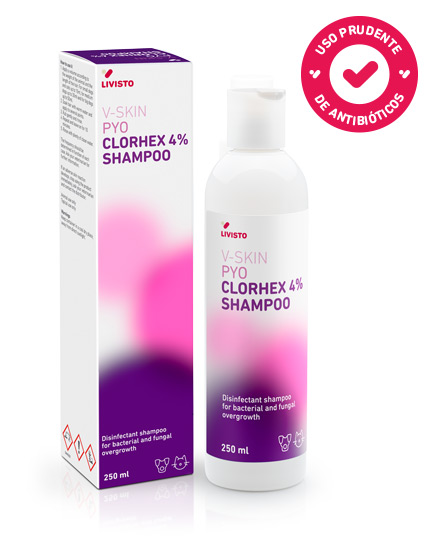SKIN INFECCIONES CUTÁNEAS Y PIODERMA
EN PERROS Y GATOSIN DOGS AND CATS
INFECCIONES CUTÁNEAS Y PIODERMA EN PERROS Y GATOS
V-SKIN
PYO
CLORHEX 4% SHAMPOO
Un tratamiento tópico eficaz es la clave para combatir las infecciones cutáneas bacterianas y fúngicas en perros y gatos.
Clorhex 4% champú tiene propiedades antisépticas, antibacterianas y antifúngicas para limpiar la piel y las heridas, dermatitis y pioderma.
No contiene sulfatos y contiene perfume hipoalergénico para reducir la sequedad cutánea y tratar con cuidado la piel de su mascota. Con jabón natural muy suave derivado del aceite de coco, mantiene el pelaje limpio y suave.

Puntos clave:
- Con clorhexidina, un eficaz componente antibacteriano, desinfectante y antiséptico.1, 2, 3, 4
- Tris-EDTA: componente antibiofilm que potencia el efecto de la clorhexidina.5, 6, 7
- Aloe Vera y caléndula para suavizar y calmar la piel lesionada.8, 9, 10, 11, 12, 13, 14, 15, 16, 17, 18
¿Cómo utilizarlo?
- Aplicar una cantidad adecuada al peso del animal y a la longitud del pelo.
- Mojar el pelo con agua tibia y aplicar en varios puntos.
- Frotar suavemente y aclarar.
- Repetir y dejar actuar durante 10 minutos.
- Aclarar con abundante agua limpia.
- La frecuencia debe determinarse en función de cada caso.
- Consulta a tu veterinario
- Evitar el contacto con los ojos
¿Cómo aplicar CLORHEX 4% SHAMPOO?
Vets opinions
Tiene un olor muy agradable, deja el pelo esponjoso y el eritema de la piel se alivia tras su uso.

Bibliografía
- Mueller, R. S., Bergvall, K., Bensignor, E., & Bond, R. (2012). A review of topical therapy for skin infections with bacteria and yeast. Veterinary Dermatology, 23(4).
https://doi.org/10.1111/j.1365-3164.2012.01057.x - Denny, J., & Munro, C. L. (2017). Chlorhexidine Bathing Effects on Health-Care-Associated Infections. Biological Research for Nursing, 19(2).
https://doi.org/10.1177/1099800416654013 - Esumi, M., Kanda, S., Shimoura, H., Hsiao, Y. H., & Iyori, K. (2021). Preliminary evaluation of two bathing methods for the management of Malassezia overgrowth in dogs with atopic dermatitis. Veterinary Dermatology, 32(3).
https://doi.org/10.1111/vde.12948 - Wan, J. (2014). A case of methicillin-resistant Staphylococcus pseudintermedius (MRSP) pyoderma in a Labrador retriever dog. Canadian Veterinary Journal, 55(11).
- Swanson, E. A., Freeman, L. J., Seleem, M. N., & Snyder, P. W. (2014). Biofilm-infected wounds in a dog. Journal of the American Veterinary Medical Association, 244(6).
https://doi.org/10.2460/javma.244.6.699 - Wooley, R. E., & Jones, M. S. (1983). Action of EDTA-Tris and antimicrobial agent combinations on selected pathogenic bacteria. Veterinary Microbiology, 8(3).
https://doi.org/10.1016/0378-1135(83)90079-2 - Buckley, L. M., Mcewan, N. A., & Nuttall, T. (2013). Tris-EDTA significantly enhances antibiotic efficacy against multidrug-resistant Pseudomonas aeruginosa in vitro. Veterinary Dermatology, 24(5).
https://doi.org/10.1111/vde.12071 - Hekmatpou, D., Mehrabi, F., Rahzani, K., & Aminiyan, A. (2019). The effect of aloe vera clinical trials on prevention and healing of skin wound: A systematic review. In Iranian Journal of Medical Sciences (Vol. 44, Issue 1).
- Sánchez, M., González-Burgos, E., Iglesias, I., & Gómez-Serranillos, M. P. (2020). Pharmacological update properties of aloe vera and its major active constituents. In Molecules (Vol. 25, Issue 6).
https://doi.org/10.3390/molecules25061324 - Teplicki, E., Ma, Q., Castillo, D. E., Zarei, M., Hustad, A. P., Chen, J., & Li, J. (2018). The effects of aloe vera on wound healing in cell proliferation, migration, and viability. Wounds, 30(9).
- Kamr, A., Arbaga, A., El-Bahrawy, A., Elsify, A., Khaled, H., & Hassan, H. (2020). The therapeutic efficacy of Aloe vera gel ointment on staphylococcal pyoderma in dogs. Veterinary World, 13(11).
https://doi.org/10.14202/VETWORLD.2020.2371-2380 - Arbaga, A., El-Bahrawy, A., Elsify, A., Khaled, H., Hassan, H. Y., & Kamr, A. (2021). Biochemical and histopathological changes related to the topical application of Aloe vera ointment for canine pyoderma. Veterinary World, 14(5).
https://doi.org/10.14202/vetworld.2021.1354-1362 - Preethia, K. C., Kuttanb, G; Kuttan, R. (2009). Anti-inflammatory activity of flower extract of Calendula officinalis Linn. and its possible mechanism of action. Indian Journal of Experimental Biology 2009 47(2).
- Tresch, M., Mevissen, M., Ayrle, H., Melzig, M., Roosje, P.; Walkenhorst, M. (2019). Medicinal plants as therapeutic options for topical treatment in canine dermatology? A systematic review. BMC Veterinary Researc, (1).
https://doi.org/10.1186/s12917-019-1854-4 - Giostri, G. S., Novak, E. M.; Guarita-Souza, L. C. (2021). Treatment of acute wounds in hand with Calendula officinalis L.: A randomized trial. Tissue Barriers.
https://doi.org/10.1080/21688370.2021.1994822 - Cruceriu, D., Balacescu, O; Rakosy, E. (2018). Calendula officinalis: Potential Roles in Cancer Treatment and Palliative Care. In Integrative Cancer Therapies (Vol. 17, Issue 4, pp. 1068–1078). SAGE Publications Inc.
https://doi.org/10.1177/1534735418803766 - Lima, M. dos R., Lopes, A. P., Martins, C., Brito, G. A. C., Carneiro, V. C; Goes, P. (2017). The effect of Calendula officinalis on oxidative stress and bone loss in experimental periodontitis. Frontiers in Physiology, (JUN).
https://doi.org/10.3389/fphys.2017.00440 - John, R.; Jan, N. (2017). Calendula Officinalis-An Important Medicinal Plant with Potential Biological Properties.Proceedings of the Indian National Science Academy,(0).
https://doi.org/10.16943/ptinsa/2017/49126


 Utilizamos cookies en nuestro sitio web para ofrecerle la experiencia más relevante al recordar sus preferencias y visitas repetidas. Al hacer clic en "Aceptar", usted consiente el uso de TODAS las cookies. Sin embargo, puede visitar Configuración de cookies para proporcionar un consentimiento controlado.
Utilizamos cookies en nuestro sitio web para ofrecerle la experiencia más relevante al recordar sus preferencias y visitas repetidas. Al hacer clic en "Aceptar", usted consiente el uso de TODAS las cookies. Sin embargo, puede visitar Configuración de cookies para proporcionar un consentimiento controlado.